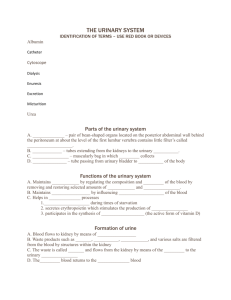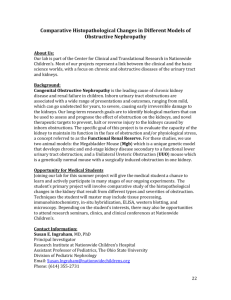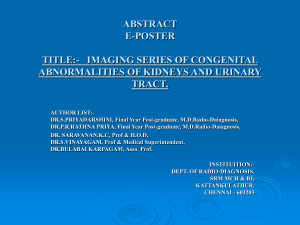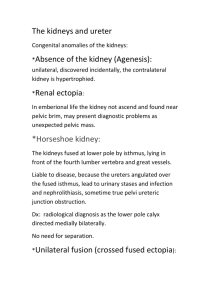Teaching-module-example-(Kidney-and-homeostasis)
advertisement
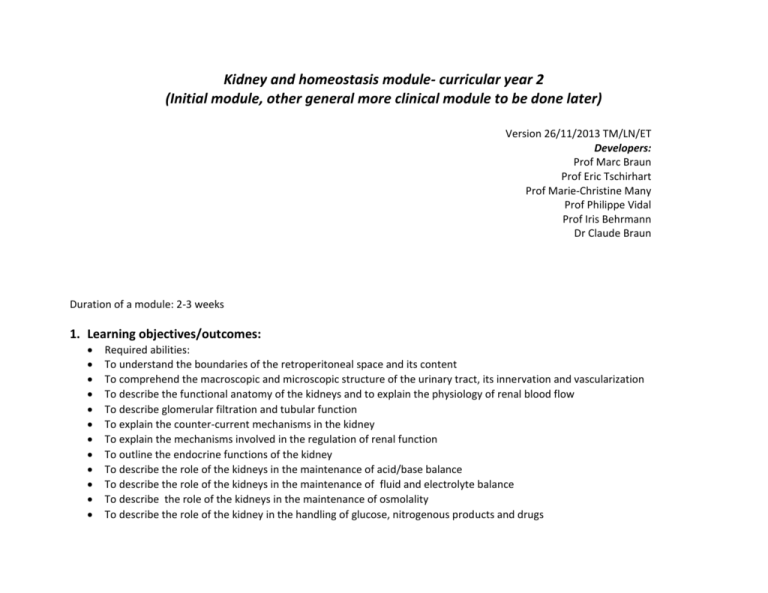
Kidney and homeostasis module- curricular year 2 (Initial module, other general more clinical module to be done later) Version 26/11/2013 TM/LN/ET Developers: Prof Marc Braun Prof Eric Tschirhart Prof Marie-Christine Many Prof Philippe Vidal Prof Iris Behrmann Dr Claude Braun Duration of a module: 2-3 weeks 1. Learning objectives/outcomes: Required abilities: To understand the boundaries of the retroperitoneal space and its content To comprehend the macroscopic and microscopic structure of the urinary tract, its innervation and vascularization To describe the functional anatomy of the kidneys and to explain the physiology of renal blood flow To describe glomerular filtration and tubular function To explain the counter-current mechanisms in the kidney To explain the mechanisms involved in the regulation of renal function To outline the endocrine functions of the kidney To describe the role of the kidneys in the maintenance of acid/base balance To describe the role of the kidneys in the maintenance of fluid and electrolyte balance To describe the role of the kidneys in the maintenance of osmolality To describe the role of the kidney in the handling of glucose, nitrogenous products and drugs To describe the principles of measurement of glomerular filtration rate and renal blood flow To describe the physiological effects and clinical assessment of renal dysfunction To explain the renal responses to hypovolaemia To cognise the interaction with the cardiovascular and respiratory system for the homeostasis of the extracellular fluid and blood pressure regulation To be able to perform simple biochemical tests and to interpret the results. To be able to discuss general principles of major and most frequently occurring pathologies of the urinary system together with basics in their diagnosis paths and treatments. To comprehend the role of kidneys in the metabolism, catabolism and elimination of drugs and medicines. Learning outcomes will be achieved through adoption of theoretical knowledge and training in different skills, with particular emphasis on case studies (PBL - Problem Based Learning). Course summary of medical disciplines: Subject Professor Course summary Anatomy Prof Marc Braun 1. Retroperitoneal space (borders and content) 2. Anatomy of the urinary system Anatomy of kidneys o External appearance o Position and projections o Relations with surrounding elements o Structure of the kidney o Blood vessels of the kidney o Kidney nervous system Urinary tract (structure, relations, projections, vascularization, inervation) o Renal calices o Renal pelvis o Ureter o Bladder o Uretra (masculine and feminine) 3. Other elements of the retroperitoneal space: Adrenal glands Major retroperitoneal abdominal blood vassels Collecting lymphatic trees of abdomen and lymphatic nodes Nerves of the retroperitoneal space 4. Introduction into major patologies of the urinary system and their relation with surrounding elements. Histology Prof Marie-Christine Many/Prof Evelyne Friederich Special histology of the urinary system Kidneys 1 Micro anatomy 2 Vascularisation 3 Glomerulus 4 Different segments of a nephron 5 Lower urinary routes 6 Urinary intra renal tracts Embryology Prof Philippe Vidal Embryology of kidney Mesoderm intermediare Embrionic kidney: 3 stages o Pronephros o Mesonephros Wolff’s canal Total or incomplete regression of Mesonephros (gender difference) o Metanephros (original form of a kidney) Diverticulum urethral and arborization of the diverticulum Formation of nephrons Ascension and rotation of kidneys Development of bladder and urethra Posterior part Anterior part Anomalies of renal development Malformations of ureter Malformations of bladder and urethra Physiology Prof Eric Tschirhart 1. Compartmentalized systems 1.1. Concept of the external and internal environment 1.2. Exchanges between compartments 1.3. Hemodynamic 1.4. Regulation of volume and osmolarity of body fluids Aquaporins, Na+/K+-ATPase, regulation via AVP/ADH, regulation via PTH, Vitamin D 1.5. Renin-Angiotensin-Aldosterone system 2. Elements of the renal physiology 2.1. Essential functions 2.2. Functional anatomy of the kidney 2.3. Glomerular filtration 2.4. Tubular systems 2.5. Regulation of the renal system 3. Acid-base homeostasis 3.1 Concept of physiological pH and acid balance - weak bases 3.2 Functional basis of pH control by the lung and the kidney Biochemistry Pharmacology (broad principles only) Prof Iris Behrmann Prof Eric Tschirhart Normal functions: (will be matched with the corresponding Physiology courses) - Excretion of metabolic end products - Regulation of the acid/base balance (pH equilibrium) proton transporters, glutamine degradation -> ammonium excretion - Endocrine functions Erythropoietin (specific aspect: Hypoxia signaling leading to Epo gene expression), - Specific aspects of the metabolism in different parts of the nephron (energy metabolism, Vitamin D, catabolism of filtrated proteins) (will be matched with the corresponding Anatomy / Cell Biology courses) - Urine: “normal” composition (+ pregnancy test: hCG content of urine) 1. Antibiotics used in treatment of urinary infections caused by most common pathogens 2. Antibiotic resistance 3. Initiation into a kidney stones treatment 4. Initiation into treatment of most frequently occuring kidney carcinoma 5. The role of kidneys in metabolism, catabolism and elimination of drugs or medicines. Manual, therapeutic and diagnostic competencies: By the end of the module: the student will know which questions to address to the patient during history taking in order to explore or exclude potential pathologies of the urinary system The student will be able to explain to the patient how to take a urine sample The student will be able to perform a physical observation of urine, to do a dipstick examination and to interpret the results. He/she will know when to request the bacteriological cultivation of the sample The student will become familiar with the treatment used for the most common urinary infections, kidney stones and most frequently occurring carcinoma of kidney It is expected that the student undertakes 2 ward rounds at the kidney ward during the module (midterm and end of a module round). Scientific competencies (E.g. Literature research on success of different therapies in treatment of urinary infections with respect to the cause of infection. Research to be concluded with a short report.) Social and communicative competences (E.g. Basics of doctor-patient approach mainly through peer to peer exercises. By the end of the module student will be able to show basic skills in appropriately balancing distance and proximity to the patient with adequate level of emotional involvement when e.g. history taking. He/she will be able to enquire respectfully and without judgment about patient`s social and family context). He/she will demonstrate clear history taking and its clear reporting to the supervisor. Human and society (Ethics and stigmatization, e.g. urinary incontinence) 2. Means of teaching-learning process are: direct contact lectures, e-learning methods, assignments, practical work, SkillLab ward rounds, cases/PBL – once per week (e.g.) o 20 years old female with urinary infection, o 60 years old male with urinary infection, o 70 years old male with kidney stone or cancer Presentation of a case in the class if followed with the discussion on hypothetical diagnosis with suggestions of a treatment. Students are directed to readings. Students` self-study period will be followed by revision of the case.




